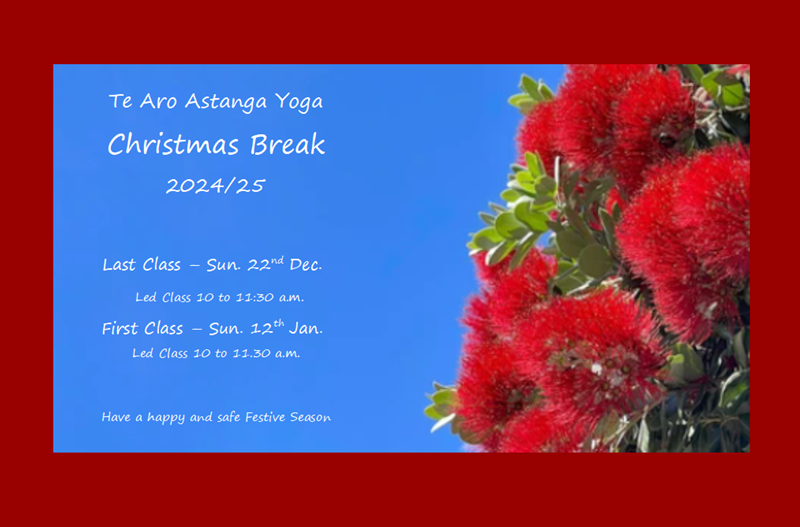The first limb of Ashtanga Yoga is Yama. This consists of 5 parts; ahimsa; satya; asteya; brahmacharya; and aparigraha. The first of these is ahimsa or nonviolence. As Guruji says in his “Yoga Mala” this means “not causing injury to anyone, including animals, in any form, at any time, or for any reason, in word, thought, or deed.”

It is important to remember that because this if the first aspect of the first limb of Ashtanga that everything else that follows must be practiced in the context of nonviolence. All of yoga is imbued with ahimsa and without this practice being central to life then you will only ever achieve limited benefit from your yoga practice. Naturally enough, this presents us with many practical and moral issues as we negotiate our way through our busy, modern lives.
At the heart of ahimsa is compassion and this must start with ones attitude to oneself in ones own practice. Your intention with the practice must be to heal oneself not to hurt oneself. Yes, we are trying to break down the ego, but this process must be done with time and compassion. It is interesting that in the “Yoga Mala” Guruji states of ahimsa that “if an injury has Vedic sanction, it does not constitute ahimsa.” In this way he indicates that, as part of the process of Asana practice injuries may occur, but that if the intention is good then this will, in the end be a positive thing. Our practice of yoga should also not be harmful to others or to the duties that our dharma requires of us. It should not be detrimental to our relationship with our partners and family and friends, or to our vocation. Do not use your yoga practice to hide from your obligations but instead to support you in fulfilling them.
In “The Yoga Sutras of Patanjali” by Edwin F Bryant, his commentary on ahimsa makes the strong case that practicing vegetarianism is essential for the aspiring yogi. This is a fair point but needs to be tempered, I think, with the fact that even eating only vegetables, one is still responsible for harming many living beings. Personally I also struggle with the distinction made between animal life and plant life and value both equally. Thus, the absolute practice of ahimsa is virtually impossible while still maintaining and ordinary level of living. Every time we drive somewhere we put insects at risk, every time we breathe, the same. Never the less, we must strive for our intention to be not to harm any other being while being pragmatic about the fact that we need live our lives.
As a practical demonstration of this, I keep bees. I am very new to this but have 2 hives. My primary purpose for this is to ensure there are enough bees in my environment and if I get to collect some honey along the way then I am happy. In order to do this I need to manage the parasite varroa that affects all hives in NZ and, if left unattended, will kill the colony. I use an organic method of oxalic acid vaporization to achieve this and my intention is to kill the varroa. I understand that I have no right to judge my bees as more worthy of existence than the varroa and yet I have made that call. I also understand that in light of this, I cannot say I practice ahimsa. This is the moral dilemma that we all face and we all must make a choice as to where we stand.
Patanjali Sutra II : 35 is “Ahimsa pratishthayam tat sannidhou vairatyagah.” This states that violence does not occur in the presence of someone who is fully established in ahimsa. Even wild animals will be calmed by the presence of a saint. This is something that I wish was realised at all levels of society today. It seems that instead, world leaders have the policy that the only way to create peace is to carry the biggest stick. Now we all know that if you threaten people with a stick, some of them will be cowed, but some will not and they will be looking around for a bigger stick, or some other means available to them to strike back. That is human nature, and we see this scenario being acted out internationally, every day. Wouldn’t it be refreshing if the leaders of the world powers decided to practice ahimsa? We would live in a much nicer place.
In conclusion, it is interesting that at this early stage of Ashtanga we are given an indication of the cyclic and organic nature of the process. The first aspect of the first limb is as difficult to achieve as the end. In fact I suspect that achieving true ahimsa is not possible until one attains asamprajnata samadhi. All the aspects of Ashtanga assist in the practice of ahimsa while being imbued in it. In the meantime, we must practice always to live our lives with the intention of least harm to all other life.

Thanks Mike – I always enjoy your blog posts… it’s the only blog I read! Being gentle to oneself is a lesson Im coming across a lot in the world of new parents… plays into that old ‘get your oxygen mask on first’ plane metaphor, but in our desire to be seen as selfless and humble we sadly ignore this. Anyway, hope you’re well and looking forward to getting back into practice soon!